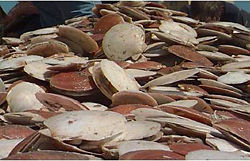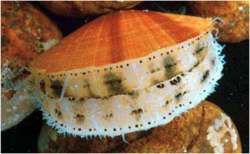Scallop (animal): Difference between revisions
Pat Palmer (talk | contribs) m (Text replacement - "Massachusetts" to "Massachusetts") |
Pat Palmer (talk | contribs) m (Text replacement - "North Carolina" to "North Carolina (U.S. state)") |
||
| Line 49: | Line 49: | ||
and skids are used to align the teeth and the bag. Bay | and skids are used to align the teeth and the bag. Bay | ||
scallop dredges are used in state waters of [[Massachusetts (U.S. state)|Massachusetts]], | scallop dredges are used in state waters of [[Massachusetts (U.S. state)|Massachusetts]], | ||
[[Rhode Island]], [[New York (disambiguation)|New York]], and [[North Carolina]]. <ref name=BayDredge>{{citation | [[Rhode Island]], [[New York (disambiguation)|New York]], and [[North Carolina (U.S. state)]]. <ref name=BayDredge>{{citation | ||
| url = http://www.nefsc.noaa.gov/nefsc/publications/tm/tm181/3.pdf | | url = http://www.nefsc.noaa.gov/nefsc/publications/tm/tm181/3.pdf | ||
| contribution = 3. Fishing Gear and Practices used in the Northeast Region: Quahog Dredges | | contribution = 3. Fishing Gear and Practices used in the Northeast Region: Quahog Dredges | ||
Revision as of 08:32, 2 August 2023
Scallops are edible shellfish, of a variety of species that are harvested commercially. They are fished with purpose-built dredges on medium-sized boats. One of the unusual characteristics of the scallop fishery is that the shells are shucked (i.e., opened) on board and only the meat brought to market; shells are often discarded to provide a growth medium for more scallops. Nevertheless, scallop shells are quite attractive and have a market to craftsmen; fishermen are also prone to use them as fillers for their driveways.
.
Scallops, of different species, have a firm-fleshed meat that tends to be much sweeter than that of other shellfish; one will never confuse the taste and texture of a clam or oyster whith that of a scallop.
They are of family Pectinidae and order Ostreoid.[1] All scallops can propel themselves by water jets. Two major varieties are the large sea scallop and the small bay scallop.
Atlantic sea scallop
One of the major species is the Atlantic Sea Scallop, Placopecten magellanicus. While the population is high, this is partially due to fisheries monitoring surveillance and control; fisheries authorities periodically close areas whose populations are made up of young scallops. In 2007, the sea scallop fishery was the most valuable in the United States. [2]
There are variations of sea scallop dredges, or its use, depending if the bottom is rocky or sandy. A hard-bottom dredge is stronger. Commercial fishermen often use sophisticated sonar, and when water visibility permits, video cameras to judge the bottom in a planned fishing area; they are consumers of high-resolution bathymetric charts produced by oceanographers. New Bedford-style dredges are typically 4.3 m (14 ft) wide; one or two of them are towed by single vessels at speeds of 4-5 knots (7.4-9.3 km/hr). New Bedford-style dredges used along the Maine coast are smaller. Dredges used on hard bottoms are heavier and stronger than dredges used on sand. Towing times are highly variable, depending on the density of marketable-sized sea scallops at any given location. Tows can be as short as 10 min or as long as 1 hr.[3]
Bay scallops
Bay scallops, Argopecten irradians, are smaller.[4] Some people consider them even sweeter than sea scallops, although their small size may make for a less interesting chewing experience. They are in somewhat more danger of overfishing, and there is experimental aquaculture.
They are taken with a smaller dredge, 1.0-1.5 m (3.3-4.9 ft) wide and about twice as long. The simplest bay scallop dredge can be just a mesh bag attached to a metal frame that is pulled along the bottom. For bay scallops that are located on sand and pebble bottom, a small set of raking teeth is set on a steel frame, and skids are used to align the teeth and the bag. Bay scallop dredges are used in state waters of Massachusetts, Rhode Island, New York, and North Carolina (U.S. state). [5]
References
- ↑ Hart DR, Chute AS (2004), Essential fish habitat source document: Sea scallop, Placopecten magellanicus, life history and habitat characteristics (2nd edition. NOAA Tech Memo NMFS NE 189 ed.)
- ↑ Fish Watch: Atlantic Sea Scallop (Placopecten magellanicus), National Oceanographic and Atmospheric Administration
- ↑ David Stevenson et al., 3. Fishing Gear and Practices used in the Northeast Region: Quahog Dredges, NOAA Technical Memorandum NMFS NE 181: Characterization of the Fishing Practices and Marine Benthic Ecosystems of the Northeast U.S. Shelf, and an Evaluation of the Potential Effects of Fishing on Essential Fish Habitat, National Oceanographic and Atmospheric Administration, pp. 46-47
- ↑ Cleinon W. Fay, Richard J. Neves, and Garland 8. Pardue (October 1983), Species Profiles: Life Histories and Environmental Requirements of Coastal Fishes and Invertebrates (Mid-Atlantic): BAY SCALLOP, Department of Fisheries and Willdlife Sciences, Virginia Polytechnic and State University, for the National Fish and Wildlife Service
- ↑ David Stevenson et al., 3. Fishing Gear and Practices used in the Northeast Region: Quahog Dredges, NOAA Technical Memorandum NMFS NE 181: Characterization of the Fishing Practices and Marine Benthic Ecosystems of the Northeast U.S. Shelf, and an Evaluation of the Potential Effects of Fishing on Essential Fish Habitat, National Oceanographic and Atmospheric Administration, pp. 47

